Kai Luo
THAT: Token-wise High-frequency Augmentation Transformer for Hyperspectral Pansharpening
Aug 11, 2025Abstract:Transformer-based methods have demonstrated strong potential in hyperspectral pansharpening by modeling long-range dependencies. However, their effectiveness is often limited by redundant token representations and a lack of multi-scale feature modeling. Hyperspectral images exhibit intrinsic spectral priors (e.g., abundance sparsity) and spatial priors (e.g., non-local similarity), which are critical for accurate reconstruction. From a spectral-spatial perspective, Vision Transformers (ViTs) face two major limitations: they struggle to preserve high-frequency components--such as material edges and texture transitions--and suffer from attention dispersion across redundant tokens. These issues stem from the global self-attention mechanism, which tends to dilute high-frequency signals and overlook localized details. To address these challenges, we propose the Token-wise High-frequency Augmentation Transformer (THAT), a novel framework designed to enhance hyperspectral pansharpening through improved high-frequency feature representation and token selection. Specifically, THAT introduces: (1) Pivotal Token Selective Attention (PTSA) to prioritize informative tokens and suppress redundancy; (2) a Multi-level Variance-aware Feed-forward Network (MVFN) to enhance high-frequency detail learning. Experiments on standard benchmarks show that THAT achieves state-of-the-art performance with improved reconstruction quality and efficiency. The source code is available at https://github.com/kailuo93/THAT.
Hallucinating 360°: Panoramic Street-View Generation via Local Scenes Diffusion and Probabilistic Prompting
Jul 09, 2025



Abstract:Panoramic perception holds significant potential for autonomous driving, enabling vehicles to acquire a comprehensive 360{\deg} surround view in a single shot. However, autonomous driving is a data-driven task. Complete panoramic data acquisition requires complex sampling systems and annotation pipelines, which are time-consuming and labor-intensive. Although existing street view generation models have demonstrated strong data regeneration capabilities, they can only learn from the fixed data distribution of existing datasets and cannot achieve high-quality, controllable panoramic generation. In this paper, we propose the first panoramic generation method Percep360 for autonomous driving. Percep360 enables coherent generation of panoramic data with control signals based on the stitched panoramic data. Percep360 focuses on two key aspects: coherence and controllability. Specifically, to overcome the inherent information loss caused by the pinhole sampling process, we propose the Local Scenes Diffusion Method (LSDM). LSDM reformulates the panorama generation as a spatially continuous diffusion process, bridging the gaps between different data distributions. Additionally, to achieve the controllable generation of panoramic images, we propose a Probabilistic Prompting Method (PPM). PPM dynamically selects the most relevant control cues, enabling controllable panoramic image generation. We evaluate the effectiveness of the generated images from three perspectives: image quality assessment (i.e., no-reference and with reference), controllability, and their utility in real-world Bird's Eye View (BEV) segmentation. Notably, the generated data consistently outperforms the original stitched images in no-reference quality metrics and enhances downstream perception models. The source code will be publicly available at https://github.com/Bryant-Teng/Percep360.
Panoramic Out-of-Distribution Segmentation
May 06, 2025Abstract:Panoramic imaging enables capturing 360{\deg} images with an ultra-wide Field-of-View (FoV) for dense omnidirectional perception. However, current panoramic semantic segmentation methods fail to identify outliers, and pinhole Out-of-distribution Segmentation (OoS) models perform unsatisfactorily in the panoramic domain due to background clutter and pixel distortions. To address these issues, we introduce a new task, Panoramic Out-of-distribution Segmentation (PanOoS), achieving OoS for panoramas. Furthermore, we propose the first solution, POS, which adapts to the characteristics of panoramic images through text-guided prompt distribution learning. Specifically, POS integrates a disentanglement strategy designed to materialize the cross-domain generalization capability of CLIP. The proposed Prompt-based Restoration Attention (PRA) optimizes semantic decoding by prompt guidance and self-adaptive correction, while Bilevel Prompt Distribution Learning (BPDL) refines the manifold of per-pixel mask embeddings via semantic prototype supervision. Besides, to compensate for the scarcity of PanOoS datasets, we establish two benchmarks: DenseOoS, which features diverse outliers in complex environments, and QuadOoS, captured by a quadruped robot with a panoramic annular lens system. Extensive experiments demonstrate superior performance of POS, with AuPRC improving by 34.25% and FPR95 decreasing by 21.42% on DenseOoS, outperforming state-of-the-art pinhole-OoS methods. Moreover, POS achieves leading closed-set segmentation capabilities. Code and datasets will be available at https://github.com/MengfeiD/PanOoS.
DAE-KAN: A Kolmogorov-Arnold Network Model for High-Index Differential-Algebraic Equations
Apr 22, 2025Abstract:Kolmogorov-Arnold Networks (KANs) have emerged as a promising alternative to Multi-Layer Perceptrons (MLPs) due to their superior function-fitting abilities in data-driven modeling. In this paper, we propose a novel framework, DAE-KAN, for solving high-index differential-algebraic equations (DAEs) by integrating KANs with Physics-Informed Neural Networks (PINNs). This framework not only preserves the ability of traditional PINNs to model complex systems governed by physical laws but also enhances their performance by leveraging the function-fitting strengths of KANs. Numerical experiments demonstrate that for DAE systems ranging from index-1 to index-3, DAE-KAN reduces the absolute errors of both differential and algebraic variables by 1 to 2 orders of magnitude compared to traditional PINNs. To assess the effectiveness of this approach, we analyze the drift-off error and find that both PINNs and DAE-KAN outperform classical numerical methods in controlling this phenomenon. Our results highlight the potential of neural network methods, particularly DAE-KAN, in solving high-index DAEs with substantial computational accuracy and generalization, offering a promising solution for challenging partial differential-algebraic equations.
Omnidirectional Multi-Object Tracking
Mar 06, 2025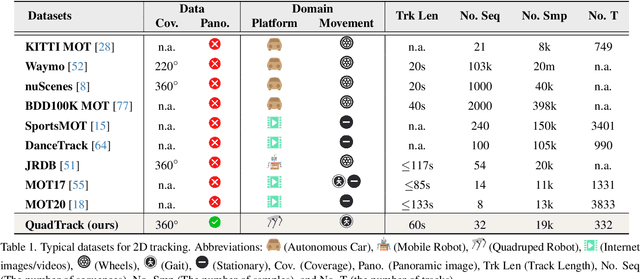
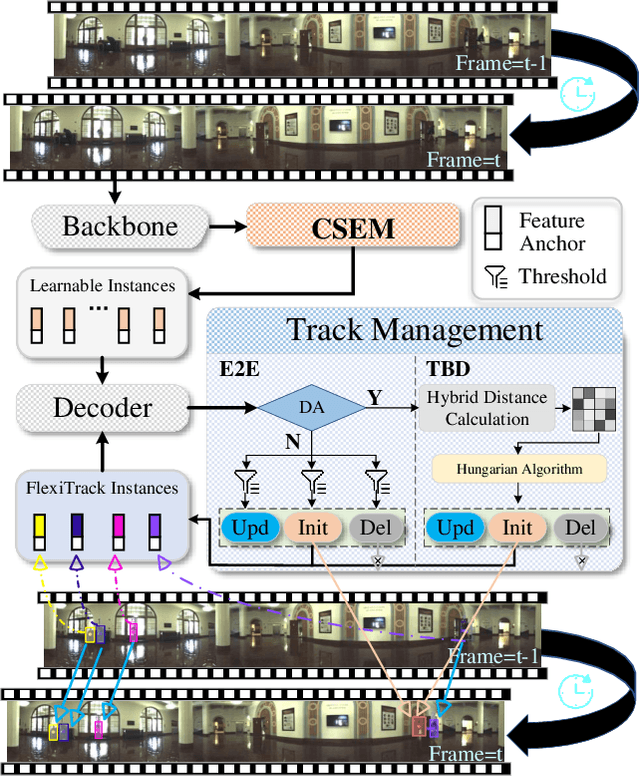
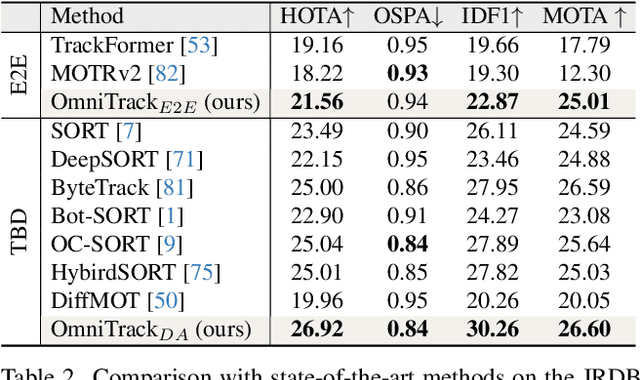

Abstract:Panoramic imagery, with its 360{\deg} field of view, offers comprehensive information to support Multi-Object Tracking (MOT) in capturing spatial and temporal relationships of surrounding objects. However, most MOT algorithms are tailored for pinhole images with limited views, impairing their effectiveness in panoramic settings. Additionally, panoramic image distortions, such as resolution loss, geometric deformation, and uneven lighting, hinder direct adaptation of existing MOT methods, leading to significant performance degradation. To address these challenges, we propose OmniTrack, an omnidirectional MOT framework that incorporates Tracklet Management to introduce temporal cues, FlexiTrack Instances for object localization and association, and the CircularStatE Module to alleviate image and geometric distortions. This integration enables tracking in large field-of-view scenarios, even under rapid sensor motion. To mitigate the lack of panoramic MOT datasets, we introduce the QuadTrack dataset--a comprehensive panoramic dataset collected by a quadruped robot, featuring diverse challenges such as wide fields of view, intense motion, and complex environments. Extensive experiments on the public JRDB dataset and the newly introduced QuadTrack benchmark demonstrate the state-of-the-art performance of the proposed framework. OmniTrack achieves a HOTA score of 26.92% on JRDB, representing an improvement of 3.43%, and further achieves 23.45% on QuadTrack, surpassing the baseline by 6.81%. The dataset and code will be made publicly available at https://github.com/xifen523/OmniTrack.
Unveiling the Potential of Segment Anything Model 2 for RGB-Thermal Semantic Segmentation with Language Guidance
Mar 04, 2025Abstract:The perception capability of robotic systems relies on the richness of the dataset. Although Segment Anything Model 2 (SAM2), trained on large datasets, demonstrates strong perception potential in perception tasks, its inherent training paradigm prevents it from being suitable for RGB-T tasks. To address these challenges, we propose SHIFNet, a novel SAM2-driven Hybrid Interaction Paradigm that unlocks the potential of SAM2 with linguistic guidance for efficient RGB-Thermal perception. Our framework consists of two key components: (1) Semantic-Aware Cross-modal Fusion (SACF) module that dynamically balances modality contributions through text-guided affinity learning, overcoming SAM2's inherent RGB bias; (2) Heterogeneous Prompting Decoder (HPD) that enhances global semantic information through a semantic enhancement module and then combined with category embeddings to amplify cross-modal semantic consistency. With 32.27M trainable parameters, SHIFNet achieves state-of-the-art segmentation performance on public benchmarks, reaching 89.8% on PST900 and 67.8% on FMB, respectively. The framework facilitates the adaptation of pre-trained large models to RGB-T segmentation tasks, effectively mitigating the high costs associated with data collection while endowing robotic systems with comprehensive perception capabilities. The source code will be made publicly available at https://github.com/iAsakiT3T/SHIFNet.
Image Gradient-Aided Photometric Stereo Network
Dec 16, 2024Abstract:Photometric stereo (PS) endeavors to ascertain surface normals using shading clues from photometric images under various illuminations. Recent deep learning-based PS methods often overlook the complexity of object surfaces. These neural network models, which exclusively rely on photometric images for training, often produce blurred results in high-frequency regions characterized by local discontinuities, such as wrinkles and edges with significant gradient changes. To address this, we propose the Image Gradient-Aided Photometric Stereo Network (IGA-PSN), a dual-branch framework extracting features from both photometric images and their gradients. Furthermore, we incorporate an hourglass regression network along with supervision to regularize normal regression. Experiments on DiLiGenT benchmarks show that IGA-PSN outperforms previous methods in surface normal estimation, achieving a mean angular error of 6.46 while preserving textures and geometric shapes in complex regions.
* 13 pages, 5 figures, published to Springer
Towards Consistent Object Detection via LiDAR-Camera Synergy
May 02, 2024Abstract:As human-machine interaction continues to evolve, the capacity for environmental perception is becoming increasingly crucial. Integrating the two most common types of sensory data, images, and point clouds, can enhance detection accuracy. However, currently, no model exists that can simultaneously detect an object's position in both point clouds and images and ascertain their corresponding relationship. This information is invaluable for human-machine interactions, offering new possibilities for their enhancement. In light of this, this paper introduces an end-to-end Consistency Object Detection (COD) algorithm framework that requires only a single forward inference to simultaneously obtain an object's position in both point clouds and images and establish their correlation. Furthermore, to assess the accuracy of the object correlation between point clouds and images, this paper proposes a new evaluation metric, Consistency Precision (CP). To verify the effectiveness of the proposed framework, an extensive set of experiments has been conducted on the KITTI and DAIR-V2X datasets. The study also explored how the proposed consistency detection method performs on images when the calibration parameters between images and point clouds are disturbed, compared to existing post-processing methods. The experimental results demonstrate that the proposed method exhibits excellent detection performance and robustness, achieving end-to-end consistency detection. The source code will be made publicly available at https://github.com/xifen523/COD.
RMAFF-PSN: A Residual Multi-Scale Attention Feature Fusion Photometric Stereo Network
Apr 14, 2024


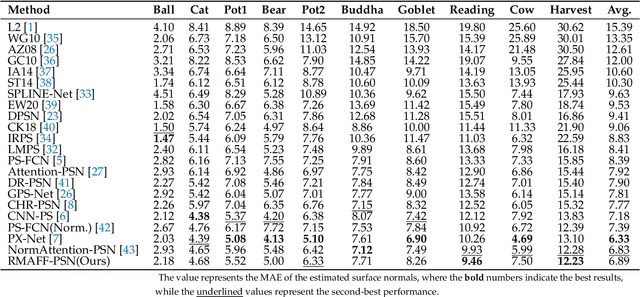
Abstract:Predicting accurate normal maps of objects from two-dimensional images in regions of complex structure and spatial material variations is challenging using photometric stereo methods due to the influence of surface reflection properties caused by variations in object geometry and surface materials. To address this issue, we propose a photometric stereo network called a RMAFF-PSN that uses residual multiscale attentional feature fusion to handle the ``difficult'' regions of the object. Unlike previous approaches that only use stacked convolutional layers to extract deep features from the input image, our method integrates feature information from different resolution stages and scales of the image. This approach preserves more physical information, such as texture and geometry of the object in complex regions, through shallow-deep stage feature extraction, double branching enhancement, and attention optimization. To test the network structure under real-world conditions, we propose a new real dataset called Simple PS data, which contains multiple objects with varying structures and materials. Experimental results on a publicly available benchmark dataset demonstrate that our method outperforms most existing calibrated photometric stereo methods for the same number of input images, especially in the case of highly non-convex object structures. Our method also obtains good results under sparse lighting conditions.
* 17 pages,12 figures
Within-basket Recommendation via Neural Pattern Associator
Jan 25, 2024
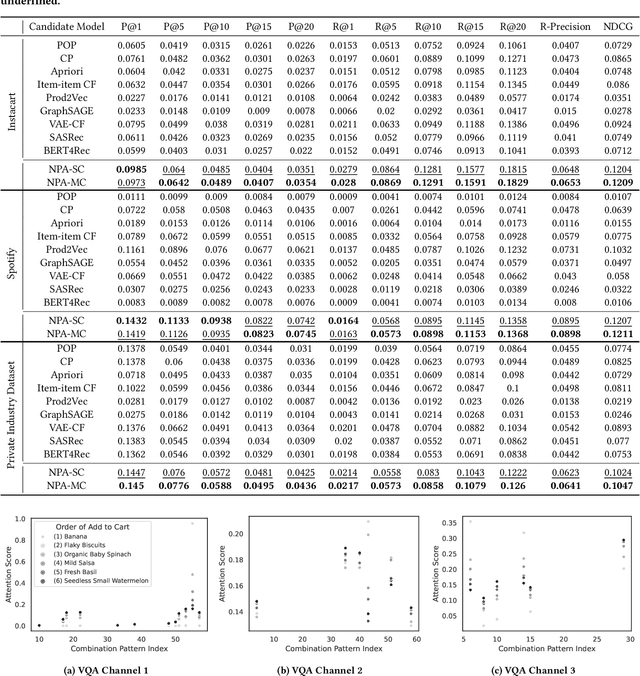


Abstract:Within-basket recommendation (WBR) refers to the task of recommending items to the end of completing a non-empty shopping basket during a shopping session. While the latest innovations in this space demonstrate remarkable performance improvement on benchmark datasets, they often overlook the complexity of user behaviors in practice, such as 1) co-existence of multiple shopping intentions, 2) multi-granularity of such intentions, and 3) interleaving behavior (switching intentions) in a shopping session. This paper presents Neural Pattern Associator (NPA), a deep item-association-mining model that explicitly models the aforementioned factors. Specifically, inspired by vector quantization, the NPA model learns to encode common user intentions (or item-combination patterns) as quantized representations (a.k.a. codebook), which permits identification of users's shopping intentions via attention-driven lookup during the reasoning phase. This yields coherent and self-interpretable recommendations. We evaluated the proposed NPA model across multiple extensive datasets, encompassing the domains of grocery e-commerce (shopping basket completion) and music (playlist extension), where our quantitative evaluations show that the NPA model significantly outperforms a wide range of existing WBR solutions, reflecting the benefit of explicitly modeling complex user intentions.
 Add to Chrome
Add to Chrome Add to Firefox
Add to Firefox Add to Edge
Add to Edge